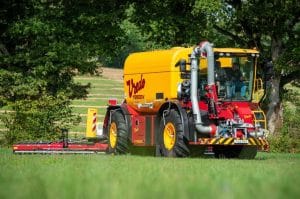Built by Hesston in the USA, Massey Ferguson launches the SB.1436DB double small square baler. It produces two rows of small bales in one pass, thus increasing capacity and minimizing field time.
AGCO releases the Massey Ferguson SB.1436DB small square baler. Producing two rows of bales per field pass doubles output of a single baler that produces 14-by-18-inch bales, this revolutionary baler delivers greater field performance, superior bale consistency and tremendous uptime to help commercial hay producers meet today’s challenges.
“The SB.1436DB is built to meet the needs of modern hay producers who face increasing pressure from labor shortages, tight harvest windows and demanding quality standards,” said Dane Mosel, marketing manager, Massey Ferguson. “This baler helps operators achieve better efficiency and superior results, reducing costs for increased profitability.”
The SB.1436DB is designed to help producers meet tight harvest windows with lower costs and increasing productivity. It produces two rows of bales per pass, reducing labor, equipment and fuel costs while maximizing productivity. A 105-inch pickup width leads to greater throughput and capacity. The machine operates at 90 strokes per minute with a 21.9-inch stroke length for efficient performance. It automates bale density, weight and dimensions with the “SimplEbale” system for consistent results to eliminate productivity losses caused by manual errors.
The SB.1436DB delivers bales with uniform density, shape and size. It produces dense, 14-by-18-inch bales that stack easily and retain nutritional value. Independent knotter trips ensure precise bale lengths (24-52 inches) regardless of windrow variability. Completed bales are dropped into independent rows for easy handling and transport.
Twine storage holds 20 balls, producing up to 8,000 bales before refilling. Hence it doubles capacity of comparable balers. Automated knotter lubrication minimizes manual intervention, thus increasing field time. The baler enables quick and easy service access to critical components.










